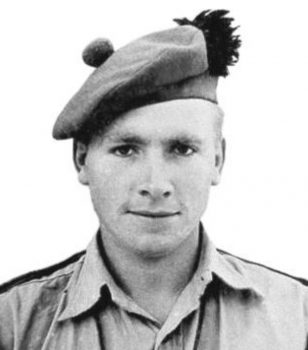
Commando come fighter pilot, Eric Garland MC and Bar, had a remarkable war. In a period full of incredible achievements by extraordinary people, the actions of Eric Garland were of the highest order. During the withdrawal from Dunkirk in June 1940 he was awarded the Military Cross for conspicuous bravery after rescuing three wounded men from a bombed and burning house during a Luftwaffe attack.
A little over a year later, having volunteered for the Commandos, he was back in action again. During the battle at Litani River in Syria his section was pinned to the open ground on the south bank of the river by heavy fire. Several casualties were taken, mainly by accurate sniper fire from a knoll on the opposite bank.
With the situation become extremely dangerous Eric Garland engaged in a high-risk strategy to save his men. From behind the limited cover, he positioned a Bren gun in front of him, and then, with complete disregard for his own safety, stood up and deliberately exposed himself to the sniper who was wreaking havoc. The sniper duly obliged and took the shot, but in the process gave away his own position, and with supreme skill and accuracy, Garland threw himself behind the Bren and shot the sniper dead.
Eric Garland’s action changed the course of the battle, with the commandos seizing the opportunity he personally led them across the river, the first man onto the enemy held bank he cut the wire while under heavy fire, and then, after capturing an anti-tank gun, used it to take out a 75mm Gun. For his cool and clear-headed leadership and complete disregard for his own personal safety, Lieutenant Eric Garland was awarded a Bar to his Military Cross.
But Eric Garlands story doesn’t end there. Despite his achievements on the ground, he had a desire to take on the enemy in the skies and joined the Royal Air Force as a fighter pilot. He gained his wings in August 1942, flew Hurricanes over the Western Desert and carried out sorties throughout the desert campaign.
Promoted to flight lieutenant in 1943, his squadron was re-equipped with Spitfires, and in 1944 they moved to Italy, where was shot down over Monte Cassino. He was captured, and despite an injured leg and burns to his hands and face, he tried unsuccessfully to escape from the POW camp three times.

Undeterred he later jumped from a hospital train near Verona and made his escape in the summer of 1944. On the run, he took refuge with a group of friendly Italians, from where he joined the partisans and took part in the action at Vasto di Sotto in which seventy-seven German soldiers were killed or captured.
Determined to rejoin the Allies, Garland fought his way back to American lines at Solarolo in January 1945 and reported back to his unit a few months later. After the war, he remained in the RAF for a further two years, and for his dedicated service to his Country was awarded the MBE in 1947.


